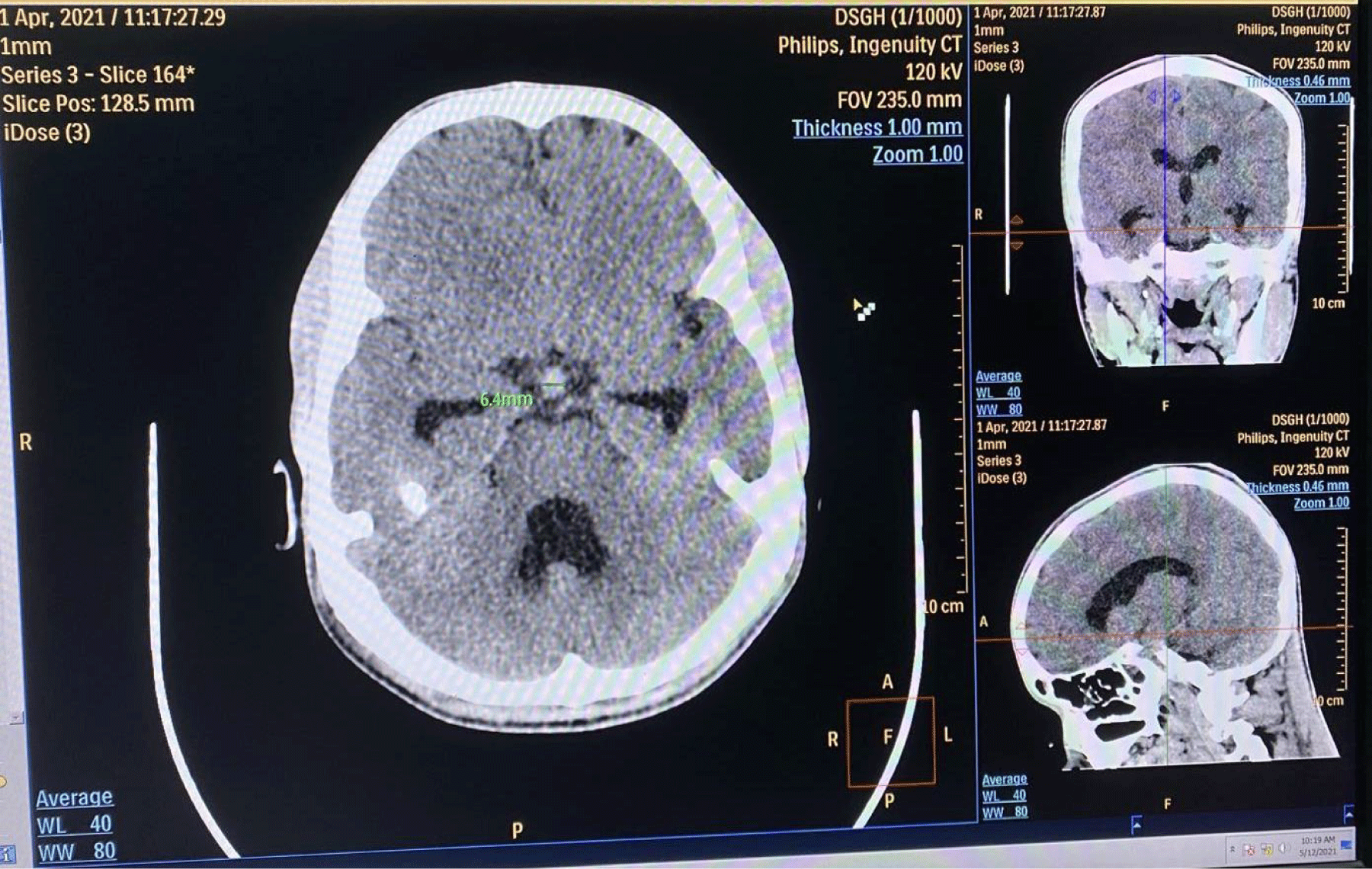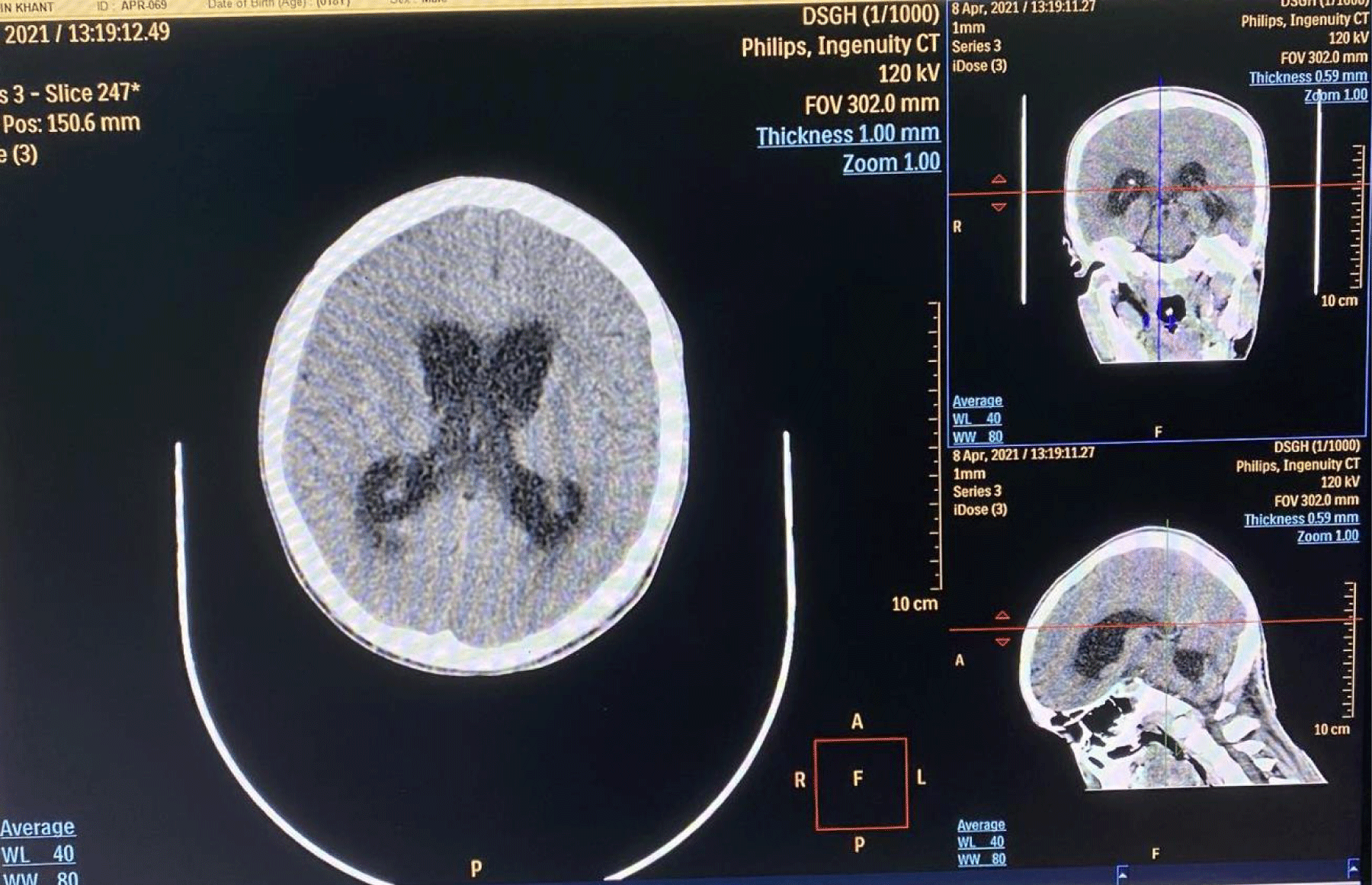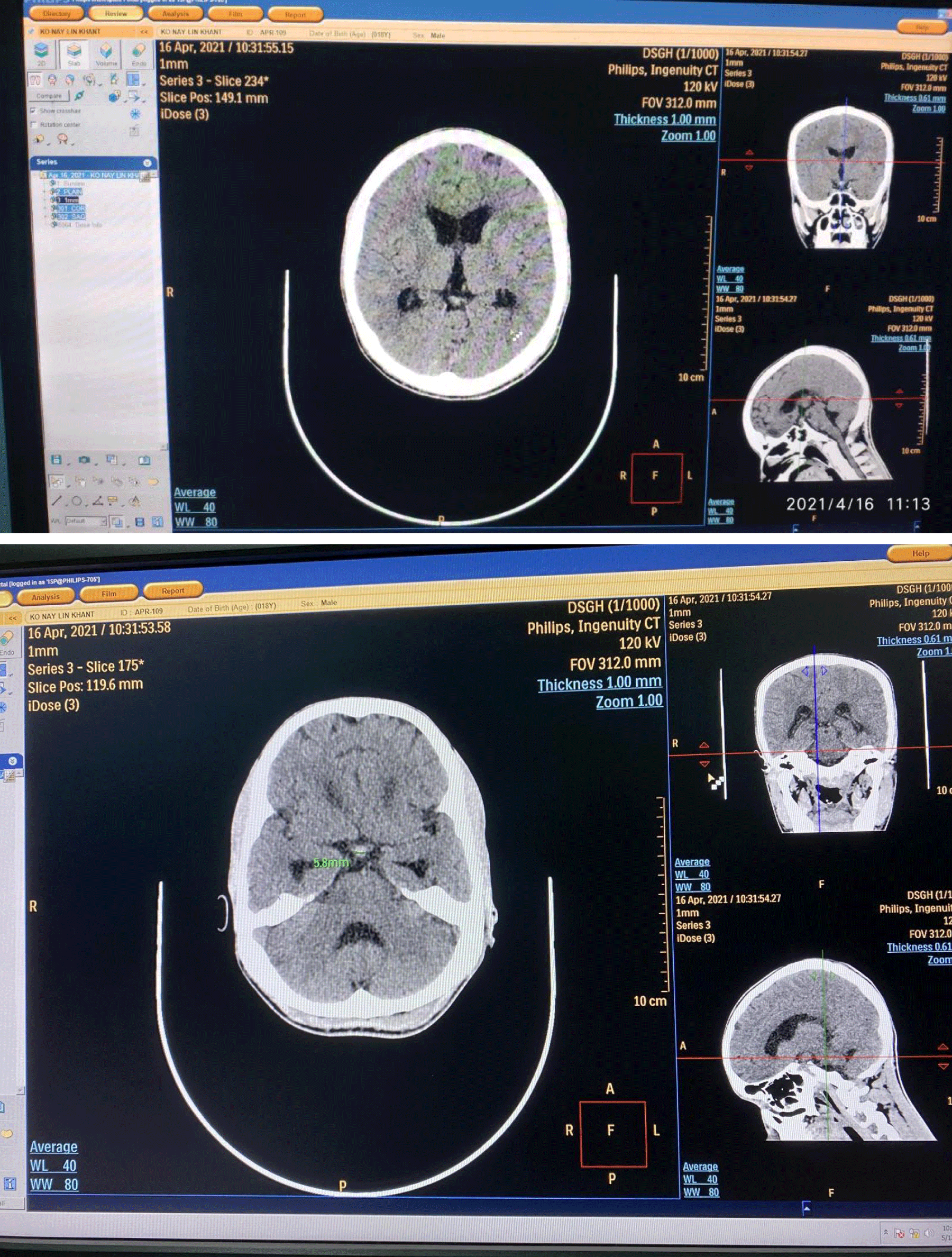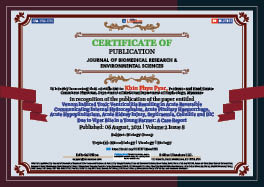> BIOLOGY Group. 2021 August 06;2(8):654-659. doi: 10.37871/jbres1293.
Venom Induced Toxic Ventriculitis Resulting in Acute Reversible Communicating Internal Hydrocephalus, Acute Pituitary Haemorrhage, Acute Hypopituitarism, Acute Kidney Injury, Septicaemia, Cellulitis and DIC Due to Viper Bite in a Young Farmer: A Case Report
Khin Phyu Pyar1*, Soe Win Hlaing2, Aung Aung3, Zar Ni Htet Aung2, Nyan Lin Maung2, Kaung Myat4, Lay Maung Maung5, Ye Min Hein5, Lynn Htet Aung6, Chan Pyae Aung7, Kyaw Thuyein Lwin8, Min Aung Hein9, Moe Tun Zaw5, Myo Maung Maung10, Aung Phyoe Kyaw5, Thein Soe Tun11 and Win Myint12
2Senior Consultant Physician, Department of Medicine No (1) Defence Services General Hospital (1000-Bedded), Myanmar
3Consultant Physician and Haematologist, Department of Haematology, No (1) Defence Services General Hospital (1000-Bedded), Myanmar
4Consultant Physician and Endocrinologist, Department of Medicine, No (1) Defence Services General Hospital (1000 Bedded), Myanmar
5Assistant Lecturer, Department of Medicine, Defence Services Medical Academy, Myanmar
6Specialist Medical Officer, No (15) Military Hospital (100-Bedded), Myanmar
7Medical Specialist, Department of Nephrology, No (1) Defence Services General Hospital (1000-Bedded)
8Consultant Physician and Nephrologist, No (1) Military Hospital (700-Bedded), Myanmar
9Consultant Physician and Nephrologist, No (2) Military Hospital (500-Bedded)
10Specialist Medical Officer, No (1) Military Hospital (500-Bedded), Myanmar
11Consultant Physician and Endocrinologist, Department of Medicine, No (1) Defence Services General Hospital (1000-Bedded), Myanmar
12Associate Professor and Consultant Neuro Physician, Department of Medicine, No (1) Defence Services General Hospital (1000-Bedded), Myanmar
- Communicating internal hydrocephalus; Acute pituitary haemorrhage; Acute hypopituitarism; Acute kidney injury; Septicaemia; Cellulitis; DIC; Viper bite
Abstract
A young farmer, tenth standard student, helping his grandfather during holiday, developed anuria after viper bite. Because of headache, non-enhanced CT scan head was done on admission which showed a small pituitary haemorrhage with normal ventricles. Later, he had generalized fits and second non-enhanced CT scan head was repeated which revealed a small pituitary haemorrhage with dilated ventricles. He also had acute kidney injury, septicaemia, cellulitis and DIC. The serum level of TSH, free T3 & free T4 were low; thus, replacement was done. Cerebrospinal fluid study (protein, sugar, cells) including culture was normal. Renal replacement therapy (haemodialysis), platelets transfusion and antibiotics were given. He had torrential polyuria (urine output 12 liter per day) when he recovered from renal failure and it improved dramatically with desmopressin replacement. There was improvement in third non-enhanced CT scan head and fourth one was consistent with normal ventricle and reduction in size of pituitary haemorrhage.
Introduction
According to WHO, 4.5-5.4 million people are bitten by snakes annually; 1.8-2.7 million people develop clinical illness and 81,000 to 138,000 people die from complications.
According to WHO report, across the globe, average 138,000 people die annually due to venomous snake bite. The morbidity rate is high- three times that of dead cases; the common sequelae are amputation, and physical or psychological disability (World Health Organisation). Snake bite is an important cause of mortality and morbidity in Myanmar. The majority of bites in our country are due to Russell’s vipers.
Acute complications following viper bite are cellulitis, compartment syndrome, septicaemia, acute kidney injury and DIC. Unlike cobra bite, neurological sequelae are extremely rare in viper bite. However, cases of cerebrovascular accident (cerebral infarction or cerebral haemorrhage) were reported by some studies [1-3] and neuromuscular weakness were observed [4]. Endocrine and metabolic complications after viper bite has been reported by several researchers [5]. Viper bite may affect pituitary gland [6,7] and adrenal gland . They may develop early- 24 to 72 hours or late- few weeks to months [8] after bite. The mechanism is mainly due to DIC either haemorrhage within the gland or thrombosis of their main artery. However, acute pituitary haemorrhage producing acute hypopituitarism involving both anterior and posterior pituitary is very rare [9]. Acute internal hydrocephalus due to viper was neither mentioned in literature nor reported previously.
Case Presentation
Eighteen-year-old high school student, who was helping his grandfather in farming during the holidays, was bitten by a viper in the paddy field. He lives in a small village near Yay Kyi Township, Irrawaddy Division where we have most of the paddy fields. He did not receive anti-snake venom (viper). He developed oliguria and he was sent to our hospital 72 hours after bite. As he had headache, non-enhanced CT scan head was done which showed pituitary haemorrhage with normal ventricles (Figure 1).
He also had acute kidney injury, septicaemia, cellulitis and DIC. Blood for complete picture on arrival was as follows: haemoglobin 9.4 gm%, neutrophil leucocytosis (total WBC 57 x 109/L, neutrophil 84%) and thrombocytopenia (platelet 22 x 109/L). His random blood sugar was 180 mg%. Serum creatinine was 10 mg/dL; serum sodium was 123 mmol/L; serum potassium was 5.2 mmol/L; and blood urea was 218 mg/dL (normal 10-50 mg/dL). Sodium was replaced. The prothrombin time was prolonged (17.8 sec); and INR was 1.45. Bleeding time was normal (1 min) and clotting time was prolonged (92 min 10 sec). APTT was prolonged too-33.9 sec (< 26).
Even after correction of dehydration, the anuria persisted; therefore, renal replacement therapy, platelet rich-plasma infusion and antibiotics were initiated. A total of fresh whole blood 11 units, PRP 3 units and FFP 4 units were given as he had overt bleeding (epistaxis) and haemoglobin dropped to 6 gm%.
On third day, he developed generalized tonic clonic fits. He did not have history of epilepsy before. We did check his random blood sugar at the time of seizure and it was very low i.e., 34 mg/dL; therefore, intravenous 50% glucose 50 cc was given immediately. Correction of hypoglycaemia relieved fits and he became fully conscious and orientated. We were worried about ACTH deficiency causing hypoglycaemia as he had pituitary haemorrhage. Although we gave him parenteral glucose 6 hourly, he continued to have similar fits with refractory hypoglycaemia. Thus, low dose steroid was replaced; consequently, he did not develop hypoglycaemic. Later, hormonal tests were requested.
Furthermore, second non-enhanced CT scan head was repeated; it showed features of dilatation of ventricles without obvious obstruction suggestive of communicating internal hydrocephalus (Figure 2). The aqueduct of midbrain was narrow. In addition, lumbar puncture was done to detect aetiology of internal hydrocephalus: infection, trauma, malignancy. Cerebrospinal fluid was clear, colorless and it did not come under pressure; normal pressure. Cerebrospinal fluid studies were normal; Cerebrospinal fluid protein was 0.1 g/L (0.15-0.45 g/L); Cerebrospinal fluid sugar was 5.42 mmol/L (2.5-5.5 mmol/L); Cerebrospinal fluid cell count was 2 cell/mm3 (<5 cells/mm3); Cerebrospinal fluid cell type was 1 polymorph and 1 lymphocyte; and Cerebrospinal fluid culture was sterile. Neither organism was found in its Gram stain nor AFB was detected in Ziehl-Nelson stain. Blood culture was sterile too.
One week later, cellulitis and septicaemia were improved; DIC was controlled. He was fully conscious and orientated. He did not have seizures. Recheck non-enhanced CT scan head (third time) revealed reduction in size of dilated ventricles and also pituitary haemorrhage (Figure 3). His renal function became normal 11th day after bite.
His thyroid function tests were suggestive of secondary hypothyroidism; free T3 level was 1.35 pmol/L (3.1-6.8), free T4 was 5.46 pmol/L (12-22) and TSH was less than 0.005 mIU/L (0.27-4.2).
Because he had the pituitary haemorrhage on arrival to our hospital, the possibility of acute hypopituitarism was anticipated. He had been on low dose hydrocortisone since the third day of hospitalization for refractory hypoglycaemia possibly due to ACTH deficiency. Thus, his serum cortisol level (9am) was normal- 58.54 nmol/l (1.55-1750 nmol/).
Following renal recovery, 11th day after bite, he had polyuria; maximum urine output was 10 liters per day and it became normal following desmopressin replacement. The patient has neither memory deficit nor neurological deficit on recovery. Blood for complete picture on discharge was nearly normal: Haemoglobin was 11.7 gm%, total WBC was 12.7X 109/L (Neutrophils 83%), platelet count was 178X109/L; his serum creatinine was normal. Recheck non-enhanced CT scan head (fourth one) revealed reduction in size of pituitary haemorrhage and normal ventricles. (Figure 4) He went back home with Levothyroxine (50ug OD), Desmopressin 30ug OD (HS) and Prednisolone 10mg cm and 5 mg pm.
Discussion
The mortality following viper bite was high and it was due to septicaemia, acute kidney injury, DIC and multi organ failure. In one study, the independent factors predictive for death included duration from bite to arrival at the hospital more than an hour, white blood cell counts more than 20 ×109 cells/L and the presence of capillary leakage. They also found that a delay in antivenom administration (more than 4 hour) increased risk of death. In this patient, he did not receive antivenom because of transport difficulty. We did not give antivenom because it was too late- more than 72 hours after bite. We did correct the effect of venom-organ failure: acute kidney injury, cellulitis, septicaemia and DIC; and we replaced the pituitary hormone. He was very lucky to survive from multi-organ failure and acute hypopituitarism. This is the main reason for reporting.
In the study done in Siri Lanka, the neuromuscular weakness caused by various types of snakes resolved over days or weeks; but, none of them mentioned hydrocephalus [4]. The venom of viper was mainly vasculotoxic and not neurotoxic. Thus, the reported cases of neurological deficits like aphasia and hemiplegia were results of either cerebral haemorrhage; haemorrhagic sequelae of DIC, or cerebral infarction; thrombotic sequelae of DIC.
In this case, he had drowsiness, generalized fits and acute internal hydrocephalus were the presentations of neurological manifestations. Although drowsiness and generalized fits were due to hyponatraemia and hypoglycaemia, acute internal hydrocephalus which was newly detected in second CT scan of head was a real neurological complication.
Acute communicating internal hydrocephalus, resolved over three weeks, and exclusion of infective causes in cerebrospinal fluid study indicated the possibility of toxic ventriculitis due to viper venom. Toxic inflamed ventricles may impair cerebrospinal fluid circulation; they may produce excessive cerebrospinal fluid and there may be reduction in reabsorption of it. The process was self-limiting; the tissue fixed toxin or venom were cleared with time and the inflamed ventricles became normal. Acute communicating internal hydrocephalus due to viper bite was not mentioned previously. This patient may be first case report of “viper bite causing venom induced toxic ventriculitis with resultant acute reversible communicating internal hydrocephalus”.
Several studies pointed out hypopituitarism even with normal pituitary imaging following viper bite [6]. According to [9], unexplained hypoglycemia and hypotension were the most common findings of acute hypopituitarism at presentation. Their finding “unexplained hypoglycaemia” was also seen in our case too. In this patient, he did not have hypotension though he had features of dehydration on admission. In their finding, acute hypopituitarism was seen in first 14 days after viper bite and the earliest timing was 48 hours after bite [9]. In this case, non-enhanced CT scan head was done on arrival to hospital-72 hours after bite.
The associated findings seen in cases with acute hypopituitarism due to viper bite were multi-organ dysfunction, lower platelet counts, more bleeding and transfusions [9]. Again, their findings were very similar to this patient.
The mechanism of acute hypopituitarism is DIC which gives rise to either haemorrhage within the pituitary gland or thrombosis of the arterial circulation. However, acute pituitary haemorrhage producing acute hypopituitarism involving whole pituitary gland; both anterior and posterior pituitary is very rare [9]. It signifies another importance of this case.
Clinical awareness of acute hypopituitarism is extremely important. And timely replacement of hormone saved the patient in addition to others: renal replacement therapy, fluid and electrolytes therapy, antimicrobial therapy, platelets infusion, FFP infusion and fresh blood transfusion. It highlights the value of multi-disciplinary team approach.
Conclusion
After viper bite, a delay in antivenom administration increases risk of death. The complications are more severe and fatal if the victim does not receive antivenom. Extremely rare neurological presentations can be seen in viper bite- acute communicating internal hydrocephalus, resolved over three weeks, possibly due to venom induced toxic ventriculitis. Awareness of acute pituitary haemorrhage and its dysfunction, acute hypopituitarism involving both anterior and posterior pituitary, are important in addition to common complications: Acute kidney injury, septicaemia, cellulitis and DIC.
References
- Sattar T. Current Review on Synthesis, Composites and Multifunctional Properties of Graphene. Top Curr Chem (Cham). 2019 Mar 14;377(2):10. doi: 10.1007/s41061-019-0235-6. PMID: 30874921.
- Banerjee AN. Graphene and its derivatives as biomedical materials: future prospects and challenges. Interface Focus. 2018 Jun 6;8(3):20170056. doi: 10.1098/rsfs.2017.0056. Epub 2018 Apr 20. PMID: 29696088; PMCID: PMC5915658.
- Zhu Y, Murali S, Cai W, Li X, Suk JW, Potts JR, Ruoff RS. Graphene and graphene oxide: synthesis, properties, and applications. Adv Mater. 2010 Sep 15;22(35):3906-24. doi: 10.1002/adma.201001068. Erratum in: Adv Mater. 2010 Dec 7;22(46):5226. PMID: 20706983.
- Abbasi E, Akbarzadeh A, Kouhi M, Milani M. Graphene: Synthesis, bio-applications, and properties. Artif Cells Nanomed Biotechnol. 2016;44(1):150-6. doi: 10.3109/21691401.2014.927880. Epub 2014 Jun 30. PMID: 24978443.
- Azevedo L, Antonaya-Martin JL, Molinero-Mourelle P, Del Río-Highsmith J. Improving PMMA resin using graphene oxide for a definitive prosthodontic rehabilitation - A clinical report. J Clin Exp Dent. 2019 Jul 1;11(7):e670-e674. doi: 10.4317/jced.55883. PMID: 31516667; PMCID: PMC6730997.
- Bacali C, Badea M, Moldovan M, Sarosi C, Nastase V, Baldea I, Chiorean RS, Constantiniuc M. The Influence of Graphene in Improvement of Physico-Mechanical Properties in PMMA Denture Base Resins. Materials (Basel). 2019 Jul 23;12(14):2335. doi: 10.3390/ma12142335. PMID: 31340462; PMCID: PMC6678796.
- Ge Z, Yang L, Xiao F, Wu Y, Yu T, Chen J, Lin J, Zhang Y. Graphene Family Nanomaterials: Properties and Potential Applications in Dentistry. Int J Biomater. 2018 Dec 9;2018:1539678. doi: 10.1155/2018/1539678. PMID: 30627167; PMCID: PMC6304494.
Content Alerts
SignUp to our
Content alerts.
 This work is licensed under a Creative Commons Attribution 4.0 International License.
This work is licensed under a Creative Commons Attribution 4.0 International License.












